There’s no secret, the San Jose Sharks could not keep the puck out of their net in the 2019-20 season. The Sharks were tied with the New Jersey Devils for second-worst in the league at 2.88 goals allowed per 60 minutes last season (stats from Evolving Hockey). You aren’t going to win many hockey games when you need to score three goals to have a chance at winning. It didn’t help that the 2019-20 Sharks could only score about 2.18 goals per game, ranking 27th in the league.
Related: Sharks’ Best Players in Franchise History
Breaking that down a little further, under former head coach Peter DeBoer, the Sharks were dead last in the league allowing 3.38 goals per 60 in the first 33 games of the season. They were 21st in scoring at 2.24 goals per 60. After Dec. 11, 2019, when interim coach Bob Boughner took over, the defense seemed to improve climbing all the way up to 20th in the league allowing only 2.46 goals per 60. Not a great mark by any means, but certainly a lot better. Under Boughner, their offense slipped a bit to 25th in the league at 2.14 goals per 60. Overall, it seems like Boughner may have had a positive effect on the team.
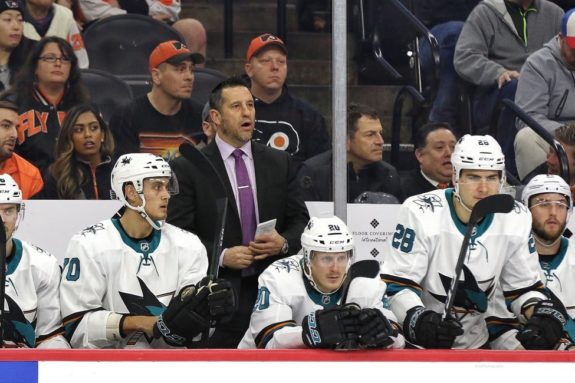
We have to keep in mind that the Sharks did suffer some major injuries that may have inhibited further positive improvement in their play under Boughner, however, there were no major injuries to excuse their play under DeBoer. Quick recap, Tomas Hertl was lost for the season on Jan. 29, Erik Karlsson was lost for the season on Feb. 15, and Logan Couture did not play in the team’s final game on March 11 due to a head injury. It is unclear if Boughner will return as head coach and other options are explored here.
I know this is supposed to be about the goalies, but it is important to review the other factors that affect a goalie.
Were the Sharks Unlucky?
Yes, definitely. The Sharks had a PDO (save percentage + shooting percentage) of .976, just barely above the epically bad and seriously less talented Detroit Red Wings. Some may argue that PDO can mean you are just bad and not unlucky, but let’s say for the sake of argument they were unlucky. Here it is in graph form from Charting Hockey:
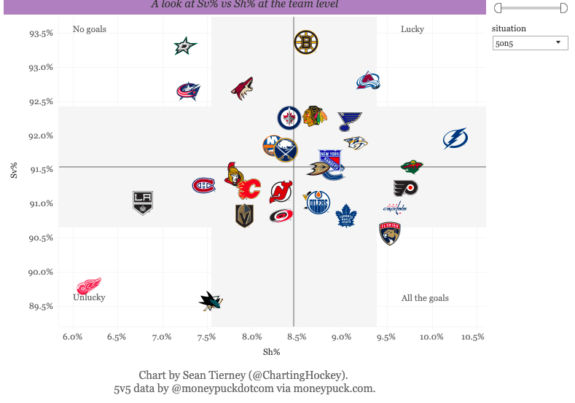
Was it Just More Than Bad Luck?
I’m going to argue yes. I’m not exactly sure what kind of system DeBoer and Boughner had in mind, but one consistent trend was that the Sharks tended to give up chances on Martin Jones and Aaron Dell from the middle of the ice. If anything, that should be the opposite of what your system allows. This image from HockeyViz aptly illustrates my point:
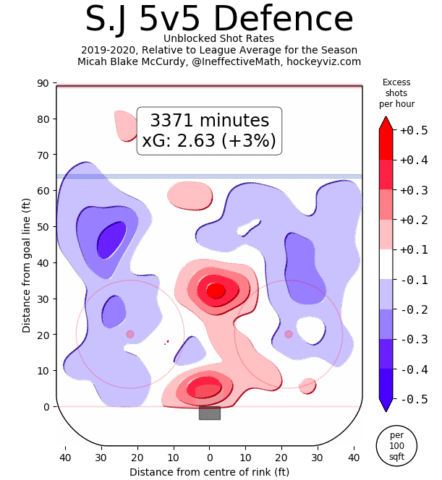
In addition to not scoring very often, the Sharks just didn’t generate that many scoring chances as evidence by this expected goals graph:
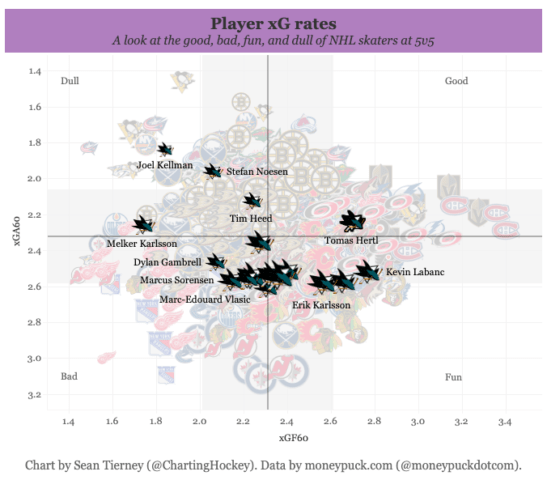
The Sharks need more than Hertl to be an effective play driver and generator of offense, while also being defensively responsible. Couture (in the middle of the cross above) needs to be better. Though it doesn’t help that he was often paired with AHL talent instead of equal scoring threats.
What About the Goalies?
On to the netminders. On a very cursory look, the Sharks’ goalies were not good.
| GP | GS | W | L | T/O | GA | SA | SV | SV% | GAA | SO | MIN | QS | QS% | RBS | |
| Martin Jones | 41 | 39 | 17 | 21 | 2 | 118 | 1139 | 1021 | .896 | 3.00 | 2 | 2360 | 15 | 0.385 | 11 |
| Aaron Dell | 33 | 30 | 12 | 15 | 3 | 92 | 986 | 894 | .907 | 3.01 | 0 | 1834 | 15 | 0.5 | 5 |
Looking at the advanced statistics, it shows things are even worse:
| GS%- | GSAA | GSAx | dfSV% | |
| Martin Jones | 115 | -15.01 | -8.52 | -0.54 |
| Aaron Dell | 103 | -2.84 | 1.1 | 0.08 |
It also shows that Dell outplayed Jones as was also evidenced by Dell stealing starts from Jones down the stretch. However, looking at Dell’s track record, aside from a dismal 2018-19 season, his numbers look okay.
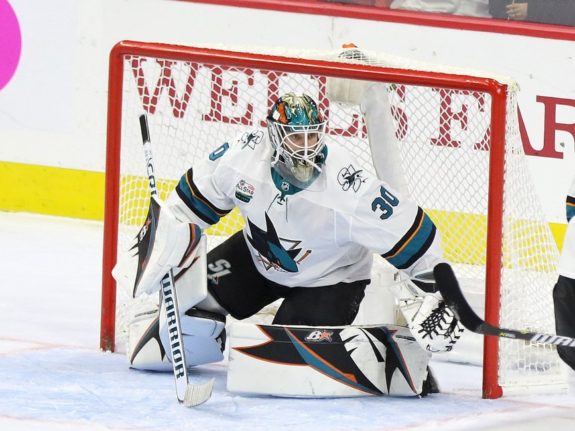
I am not sure they are starter quality, but perhaps a backup or even 1-B on the right team. However, Dell made $1.9 million in 2019-20 and likely deserves a raise or at the very worst a similar cap hit. I’m not sure it makes sense for the Sharks to bring him back at that expense. The Sharks are tight to the cap, which is expected to remain flat. They do have the Paul Martin buyout ($1.417 million) and Brenden Dillon salary retention ($1.645 million) coming off the books this year, but are in desperate need at other positions.
I have often wondered, is Jones really this bad? Did he suddenly go from being an average NHL starter to one of the worst goalies in the league?
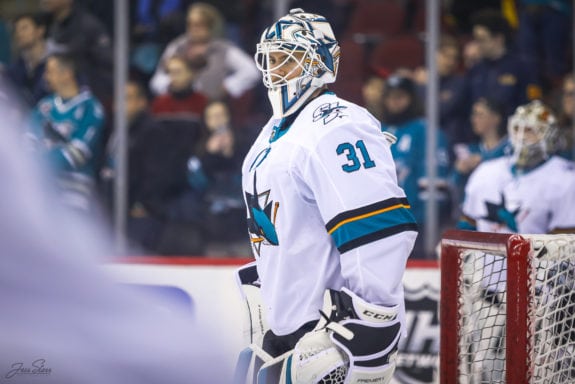
In Jones’ 37-win breakout season of 2015-16, his advanced stats were pretty good. Has he just aged prematurely? I’m not exactly sure, but I don’t see any big changes in his game. I do, however, see major changes in the play of the team in front of him. Specifically the poor play down the middle, weak defense on the left side, and overall system that allows too many high danger chances.
Related: Revisiting the Brent Burns Trade
This has gotten progressively worse over the last few years. One prime example is Marc-Edouard Vlasic. In 2015-16, when the Sharks reached the Stanley Cup Final and Vlasic was arguably in his prime, he was elite. When he was on the ice, the opposing teams had a hard time generating shots:
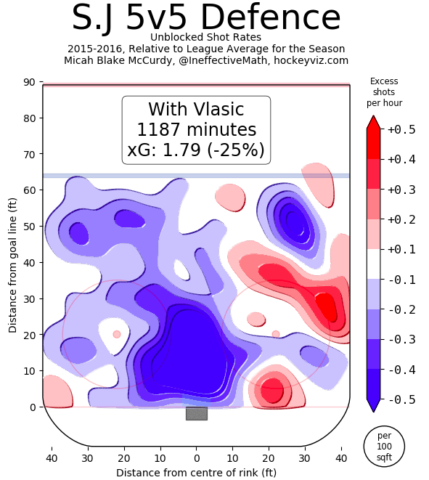
If fact, if shots did come, they invariably came from Justin Braun’s side of the ice (right). Just a few years later in 2019-20, Vlasic’s graph looks very different and perfectly illustrates the Sharks’ trouble:
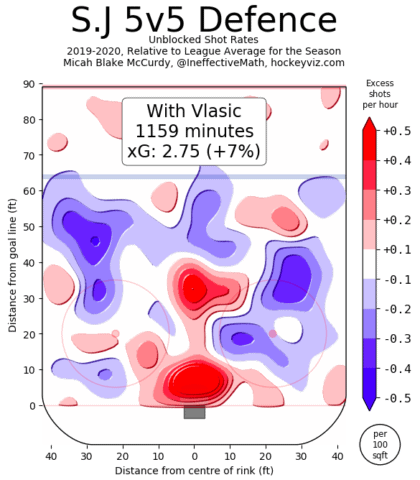
Vlasic is 33 and the Sharks are committed to him for another six years at a $7 million cap hit per year. If this year is any indication of what he has left in the tank, it is not going to be pretty for the former elite, shut-down defenseman.
So, What to Do Now?
While there are some options, none of them are good and the reality is that the Sharks are stuck with Jones through the 2023-24 season. He will be making $5.75 million during that time. I’ve often wondered if they would buy him out, but I don’t think that makes a lot of sense since they are so tight to cap already.
If however, they could sign a free agent such as Robin Lehner, that could help them extend what they think is their ongoing win-now window. Other options that might fit their cap situation better are Alexander Georgiev, Anton Khudobin, and Thomas Greiss. Greiss, a former Shark, might make sense, though I think the Sharks, like many of us, believe that Greiss’ recent success on Long Island is more due to the system there.
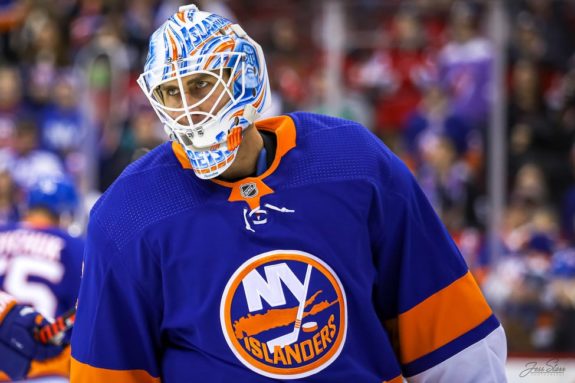
Greiss wasn’t very successful with Team Teal in the past. Georgiev is young and has shown promise. He might be able to get more money elsewhere, but the Sharks can offer him a chance at being the starter. Khudobin could be a great fit if the Sharks can convince him to come to San Jose.
Internal Options
The Sharks do have two options within the system that they hope will grab the backup job behind Jones and push him to be better, namely Josef Korenar and Alexei Melnichuk. Korenar is a 22-year-old undrafted goalie the Sharks signed in 2018 after a strong showing at both the World Junior Championship and league play in his native Czech Republic.
Korenar’s first season in the AHL 2018-19 was pretty good as he posted a 23-8-3 record for a decent San Jose Barracuda team and a .911 save percentage and 2.54 goals-against average. That ballooned to .891 and 3.11 in 2019-20 on a bad Barracuda team and his record of 12-16-7 reflects the team’s struggles. The Sharks hope Korenar can regain his 2018-19 form and even take another step forward.
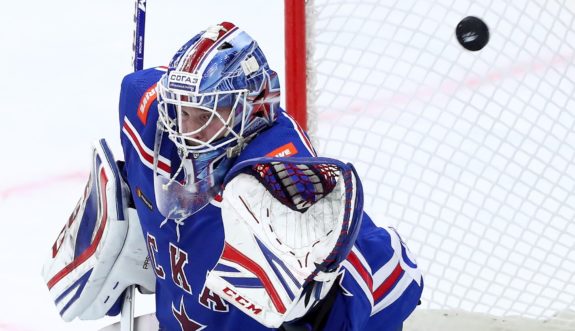
To help bolster their goaltending prospects, the Sharks signed Alexei Melnichuk in 2020 after splitting time in the VHL (analogous the AHL) and KHL. As a split-starter for perennially good SKA-St. Petersburg, Melnichuk posted a .930 save percentage and 1.68 goals against average as a 21-year-old on a very good team. It’s unclear how good Melnichuk can be on a team that isn’t as loaded as SKA, but his time in the AHL for the Barracuda should help determine that.
Final Thoughts
In the end, what is wrong with the Sharks goaltending is much more than just Jones. The team needs to work on a system that is better at limiting high-danger scoring chances. They need more from their highly paid defensive core, their underachieving forwards, and their disappointing goalies. Don’t be surprised if you continue to see Jones getting the lion’s share of the starts moving forward. I’m just not sure they have other legitimate options. Perhaps new goaltending coach Evgeni Nabokov can help return Jones to the form of an average NHL starter.
I’m sure they would love for Korenar or Melnichuk to pull a Jordan Binnington, but I wouldn’t count on it. Considering how many holes the Sharks have up front and their scoring woes, I would bet general manager Doug Wilson will spend his money there instead of in net. We have seen Jones be average and if the Sharks are going to continue to compete as they think they can when everyone is healthy again in 2020-21, that will be the low bar Jones will have to reach again.